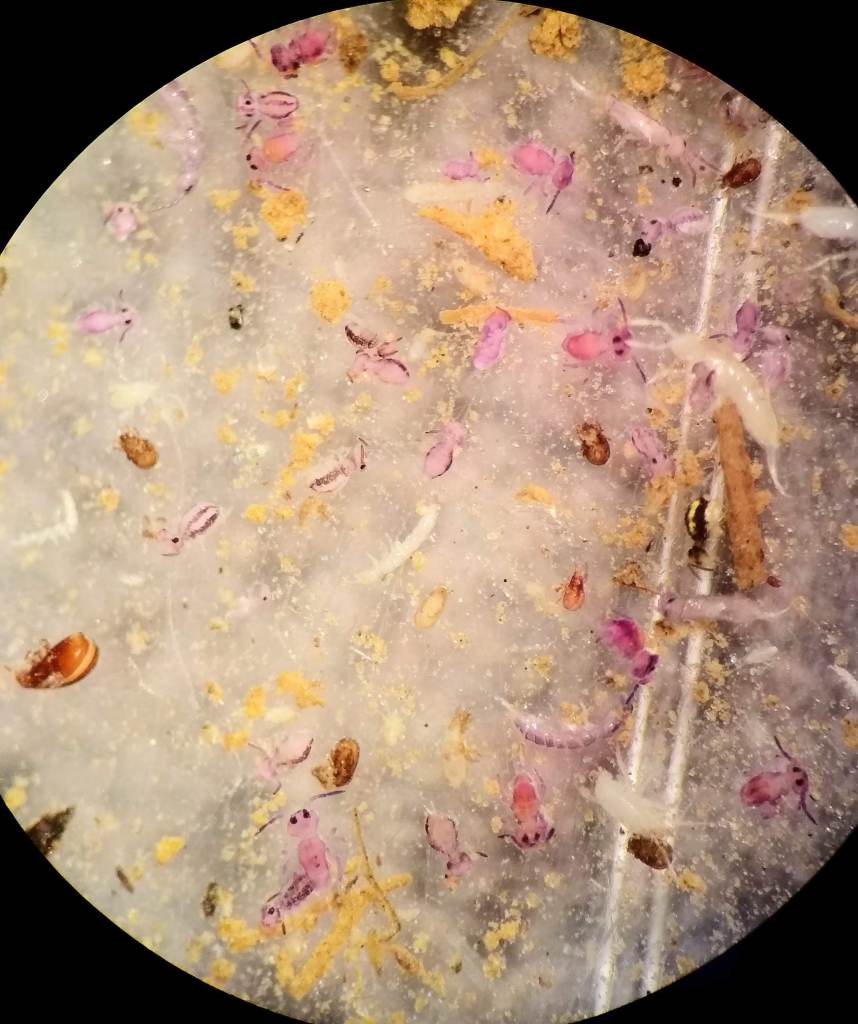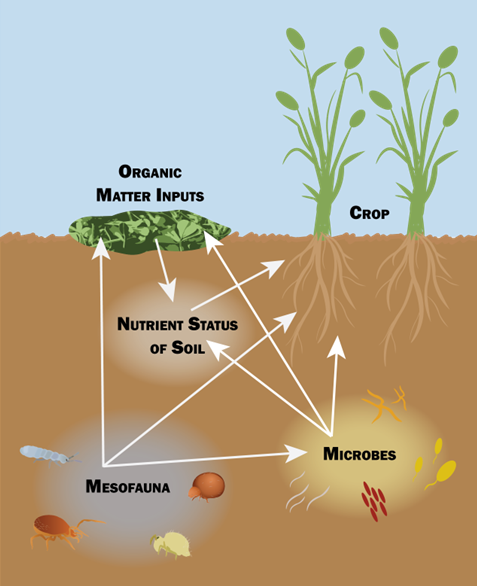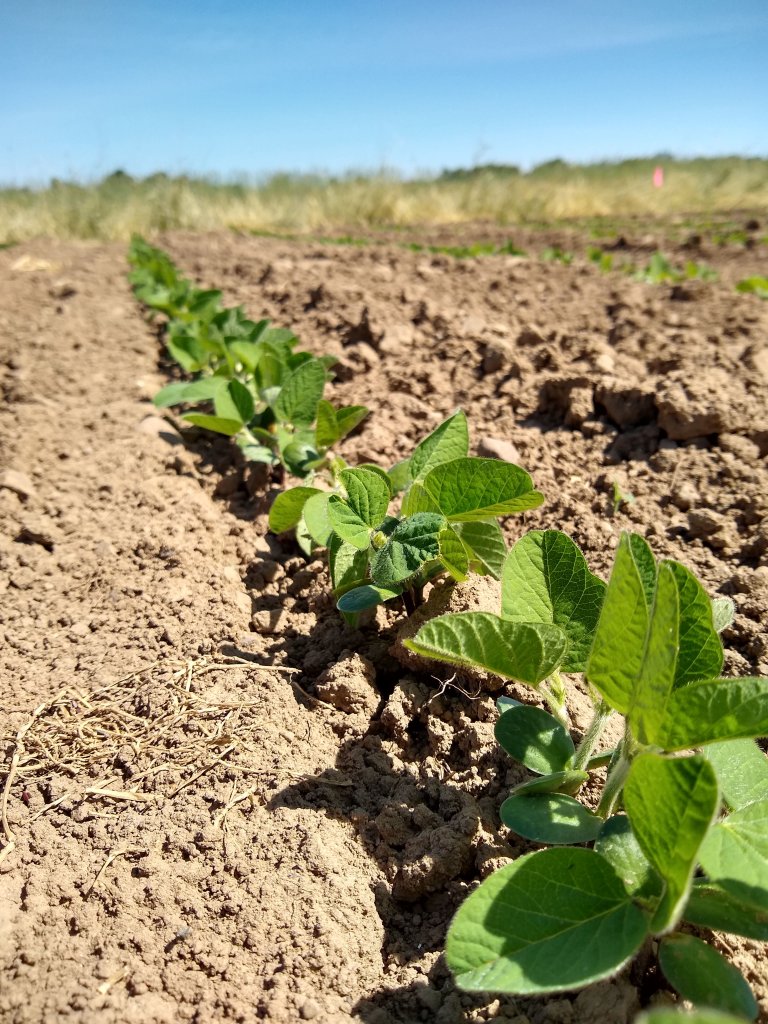Most people rarely think of the thousands, if not millions, of living things they step on every day. Soil mesofauna are the tiny arthropods that live beneath our feet, ranging in size from 100µm to 2mm, which is comparable to a grain of salt. This intermediate size category of soil arthropods includes microarthropods, a group of invertebrates dominated by collembolans and mites.

Soil microarthropods impact many soil processes that affect crop production. Most notably, microarthropods affect soil organic matter decomposition and nutrient cycling. They can also impact plant pathogen suppression and transmission, seed germination, root exudates (compounds secreted by plant roots), plant nutrient allocation and growth. Though soil mesofauna primarily affect crop production through their interactions with other factors in the soil environment, these indirect effects can add up to big impacts on crops.
The effects that soil microarthropods have on crop production are typically explored with a focus on one soil process, such as nutrient cycling or plant pathogen disease incidence, though their behaviors influence these processes simultaneously.
In 2019 and 2020, we conducted a field experiment to help us understand how the effects of microarthropods on these interconnected processes impact crop production. These relationships were investigated in both soybeans and dry beans under three different cover cropping treatments. The cover crop treatments included no cover crop with tillage (control treatment), cereal rye with tillage, and rolled cereal rye with no tillage.

Within this experiment we measured microarthropod communities, multiple microbial metrics (biomass, five extracellular enzymes, community DNA analysis), and soil characteristics that impact biological processes (soil carbon and nitrogen, aggregate stability, soil protein). We also measured select plant pathogen metrics for white mold (Sclerotinia sclerotiorum) and root rot (Fusarium spp.), along with crop production metrics (cereal rye biomass, weed suppression, and crop performance).
We modeled microarthropod effects on bean production and investigated the relative importance of nitrogen cycling, pathogen dynamics, and weed communities in the crop production outcomes. Our models focused on bean weight, as this is one of the most important metrics to farmers. Soil nutrient status was one of the most important determinants of total bean weight. Microbial biomass nitrogen was an important soil metric, consistently having a negative effect on total bean weight. This effect of the microbial biomass nitrogen could indicate a high relative importance of plant-microbe competition in crop production outcomes.

The two pathogens of interest in these crops, white mold and root rot, were not primary drivers of the crop production outcomes. White mold was not significant in any of the models, and root rot severity only appeared sporadically in the models with mixed effects. Aside from the volunteer rye, weed competition did not play a major role in the models. In the rolled cereal rye plots, volunteer rye was a major problem because of competition. However, it had a positive effect in other treatments, by providing an additional food source for the soil food web that was complementary to the beans.
Collembola, Mesostigmata mites, and Prostigmata mites were the most important microarthropods in the models. The microarthropods had more positive effects when there were more food resources available, as in the rolled cereal rye treatment. Microarthropods had the greatest abundances in the rolled cereal rye treatment, which would result in increased feeding on both soil microbes and the decomposing cereal rye roots. This would likely have caused an increase in nutrient cycling and plant available nutrients. We demonstrated that crop management decisions impact if microarthropods have a positive or negative influence on bean production.

Overall, our research indicates that the management of soil biological processes is a central determinant of crop production outcomes. Soil microarthropods specifically showed up as some of the most important drivers of these outcomes. The findings from this research can help inform sustainable crop management systems that rely on soil processes to enhance crop production.
Answered by Ashley Jernigan, Cornell University
To receive notices about future blogs, be sure to subscribe to Soils Matter by clicking on the Follow button on the upper right! Explore more on our webpage About Soils. There you will find more information about Soil Basics, Community Gardens, Green Infrastructure, Green Roofs, Soil Contaminants, materials for Teachers and more.

Thanks for sharing this useful information.
AMMC is a pioneering smart farming company in KSA, using cutting-edge technology to revolutionize agricultural practices. Buy seeds in KSA to maximise the quality and sustainability the agricultural produce. Our innovative solutions empower farmers with real-time data analysis, precision nutrient management, and intelligent farming systems to optimize resource allocation, reduce environmental impact, and enhance productivity.
Buy seeds in KSA
I would like to ask the moderator of this blog why the reply above, an unsolicited and unpaid advertisement that make it appear that SSSA is endorsing a particular company and that has nothing to do with the topic of microarthropods, was allowed to remain in this conversation. What is SSSA’s policy about ads like this?
Michael Thompson, 2024 President, SSSA